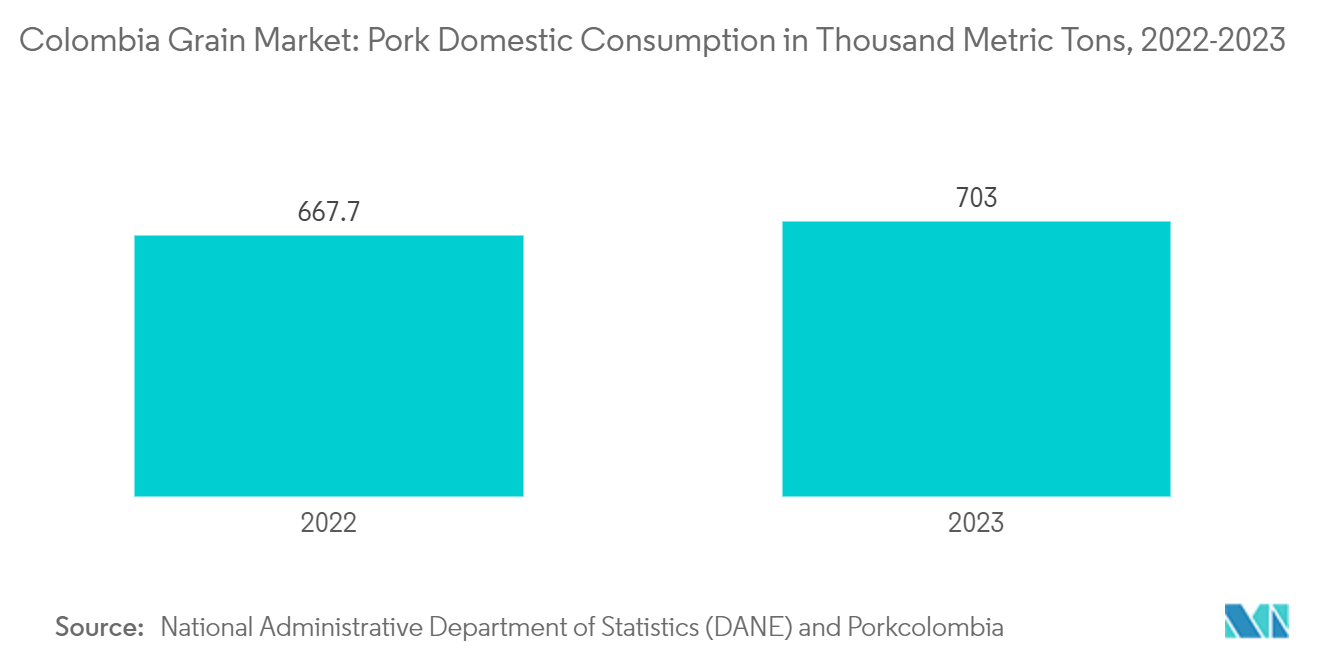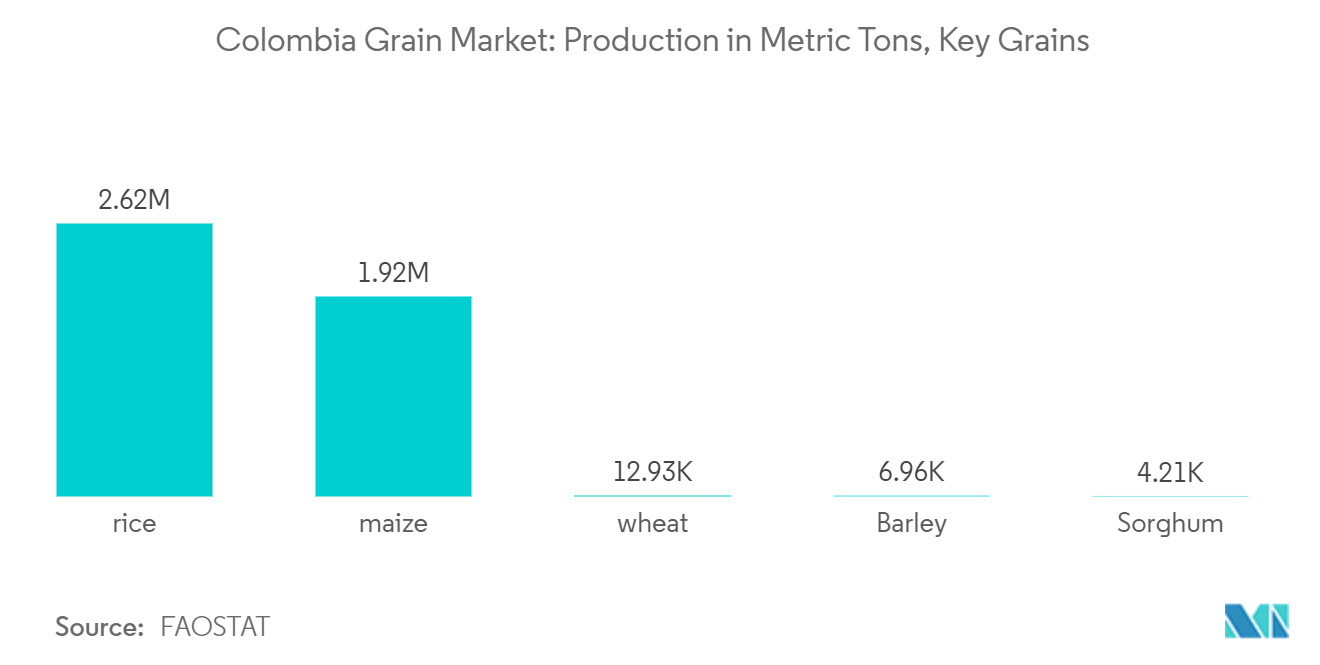Colombia Grain Market

| Study Period | 2019 - 2029 |
| Base Year For Estimation | 2023 |
| Forecast Data Period | 2024 - 2029 |
| Market Size (2024) | USD 3.13 Billion |
| Market Size (2029) | USD 3.97 Billion |
| CAGR (2024 - 2029) | 4.50 % |
Colombia Grain Market Analysis
The Colombia Grains Market size is estimated at USD 3.13 billion in 2024, and is expected to reach USD 3.97 billion by 2029, at a CAGR of 4.5% during the forecast period (2024-2029).
The long-term outlook for Colombia's grain market is positive, driven by increased consumption of wheat, rice, and other grains across various cuisines, as well as growth in processing industries producing flour, pasta, noodles, and beverages. According to the USDA Grain and Feed Annual Colombia Report 2023, the country has approximately 95 rice millers operating 121 mills, with two large companies controlling 45 percent of the market. Several factors are anticipated to contribute to increased grain consumption in Colombia during the forecast period, including population growth, increased research and development, rising health consciousness, and growing incomes, potentially leading to higher grain prices.
Changes in lifestyle and consumption patterns have led to increased demand for food grains like wheat. As a result, farmers have expanded wheat cultivation areas. FAOSTAT data shows that the area under wheat cultivation in Colombia increased from 2,600 hectares in 2021 to 4,583 hectares in 2022. This expansion in cultivation area reflects the growing importance of wheat in the country's agricultural sector.
Initiatives by government and private entities are further anticipated to drive market growth. In 2024, the Ministry of Agriculture and Rural Development, Fedearroz, and Induarroz (rice millers association) signed an agreement to enhance the competitiveness of Colombia's rice sector. This agreement allows the Colombian rice sector to use COL-RICE funds from the government to invest in drying and storage facilities. Such partnerships aim to reduce grain losses during storage and support market growth.
Colombia Grain Market Trends
Increase in Demand for Animal-based Protein Sources
Colombia's increasing population, rising incomes, and urbanization have led to a surge in animal-based protein consumption. This growth in demand for milk, meat, and eggs has intensified pressure on the meat industry, consequently increasing the need for grains in animal feed production. According to the National Administrative Department of Statistics (DANE) and Porkcolombia, pork consumption in 2023 reached 703 thousand metric tons, a 5.3% increase from the previous year's 667.7 thousand metric tons. The USDA Grain and Feed Update Report 2024 indicates that approximately 95% of corn imports are used for animal feed, with only 5% allocated for human consumption. This heightened demand for animal feed has encouraged farmers to expand their cultivation areas, resulting in increased grain production within the country.
The USDA Grain and Feed Update Report 2024 reveals that the area under corn cultivation grew from 380 thousand hectares in MY2022-2023 to 390 thousand hectares in MY2023-2024. This expansion led to a production increase from 1.5 million metric tons to 1.6 million metric tons. Consequently, the growth in both domestic production and imports of grains is primarily driven by the expanding animal feed sector in Colombia, reflecting the country's changing dietary patterns and agricultural landscape.

Rice holds a Significant Share by Production
Colombia stands as a prominent rice producer in South America. The country's rice production has increased significantly compared to other major grains, driven by growing domestic and global demand. According to FAOSTAT, Colombia's rice production in 2022 reached 2.6 million metric tons, surpassing other grain crops such as maize (1.9 million metric tons), wheat (12.9 thousand metric tons), barley (6.9 thousand metric tons), and sorghum (4.2 thousand metric tons). Government initiatives, such as Plan Colombia Siembra, have contributed to improved rice production by focusing on increasing productive agriculture for specific commodities. Additionally, the development of new rice varieties continues to enhance the sector. In August 2023, a new variety named Grandiosa was introduced, featuring improved tolerance to diseases and pests.
Rice remains a staple food in Colombia, with high per capita consumption compared to neighboring countries. The USDA estimates the average per capita consumption at 43 kg per person. Total rice consumption in MY 2023-2024 is 2 million metric tons, an increase from the previous year's 1.9 million metric tons. This upward trend in consumption underscores the importance of rice in the Colombian diet and the growing demand for this essential grain.

Colombia Grain Market News
- October 2024: In 2023, Colombia set a new record for genetically modified (GM) corn adoption, with 142,711 hectares planted. This represents a 20% increase from the previous year. GM corn now accounts for 36% of the total corn cultivation area and contributes to over 50% of the country's grain production.
- August 2024: The Colombian Ministry of Trade has extended the suspension of the Andean Price Band System (APBS) for wheat grain imports for an additional two years through 2026. This decision allows wheat from all origins to enter Colombia duty-free during this period, potentially impacting the country's wheat import dynamics and domestic market conditions.
Colombia Grains Market Report - Table of Contents
1. INTRODUCTION
1.1 Study Assumptions & Market definition
1.2 Scope of the Study
2. RESEARCH METHODOLOGY
3. EXECUTIVE SUMMARY
4. MARKET DYNAMICS
4.1 Market Overview
4.2 Market Drivers
4.2.1 Increase in Demand for Animal-based Protein Sources
4.2.2 Increasing Grains Imports to maintain Domestic Supply
4.2.3 Increasing Government Initiatives
4.3 Market Restraints
4.3.1 High Risk of Pest and Disease Occurrence
4.3.2 Price Volatility in Grains Market
4.4 Value chain analysis
5. MARKET SEGMENTATION
5.1 Rice
5.1.1 Production Analysis
5.1.2 Consumption Analysis (Volume and Value)
5.1.3 Import market (Volume & Value)
5.1.4 Export market (Volume & Value)
5.1.5 Price Trend Analysis
5.2 Maize
5.2.1 Production Analysis
5.2.2 Consumption Analysis (Volume and Value)
5.2.3 Import market (Volume & Value)
5.2.4 Export market (Volume & Value)
5.2.5 Price Trend Analysis
5.3 Sorghum
5.3.1 Production Analysis
5.3.2 Consumption Analysis (Volume and Value)
5.3.3 Import market (Volume & Value)
5.3.4 Export market (Volume & Value)
5.3.5 Price Trend Analysis
5.4 Wheat
5.4.1 Production Analysis
5.4.2 Consumption Analysis (Volume and Value)
5.4.3 Import market (Volume & Value)
5.4.4 Export market (Volume & Value)
5.4.5 Price Trend Analysis
5.5 Barley
5.5.1 Production Analysis
5.5.2 Consumption Analysis (Volume and Value)
5.5.3 Import market (Volume & Value)
5.5.4 Export market (Volume & Value)
5.5.5 Price Trend Analysis
5.6 Oats
5.6.1 Production Analysis
5.6.2 Consumption Analysis (Volume and Value)
5.6.3 Import market (Volume & Value)
5.6.4 Export market (Volume & Value)
5.6.5 Price Trend Analysis
6. MARKET OPPORTUNITIES AND FUTURE TRENDS
Colombia Grain Industry Segmentation
Grains are small, dry, hard seeds harvested from various grass species, including oats, corn, rice, and wheat. The Colombian grain market encompasses rice, maize, sorghum, wheat, barley, and oats. This report analyzes production volume, consumption volume and value, import volume and value, export volume and value, and price trends for these grain segments. Additionally, the report provides market size and forecasts in terms of value (USD) and volume (Metric Tons) for each segment.
| Rice | |
| Production Analysis | |
| Consumption Analysis (Volume and Value) | |
| Import market (Volume & Value) | |
| Export market (Volume & Value) | |
| Price Trend Analysis |
| Maize | |
| Production Analysis | |
| Consumption Analysis (Volume and Value) | |
| Import market (Volume & Value) | |
| Export market (Volume & Value) | |
| Price Trend Analysis |
| Sorghum | |
| Production Analysis | |
| Consumption Analysis (Volume and Value) | |
| Import market (Volume & Value) | |
| Export market (Volume & Value) | |
| Price Trend Analysis |
| Wheat | |
| Production Analysis | |
| Consumption Analysis (Volume and Value) | |
| Import market (Volume & Value) | |
| Export market (Volume & Value) | |
| Price Trend Analysis |
| Barley | |
| Production Analysis | |
| Consumption Analysis (Volume and Value) | |
| Import market (Volume & Value) | |
| Export market (Volume & Value) | |
| Price Trend Analysis |
| Oats | |
| Production Analysis | |
| Consumption Analysis (Volume and Value) | |
| Import market (Volume & Value) | |
| Export market (Volume & Value) | |
| Price Trend Analysis |
Colombia Grains Market Research Faqs
How big is the Colombia Grains Market?
The Colombia Grains Market size is expected to reach USD 3.13 billion in 2024 and grow at a CAGR of 4.5% to reach USD 3.97 billion by 2029.
What is the current Colombia Grains Market size?
In 2024, the Colombia Grains Market size is expected to reach USD 3.13 billion.
What years does this Colombia Grains Market cover, and what was the market size in 2023?
In 2023, the Colombia Grains Market size was estimated at USD 2.99 billion. The report covers the Colombia Grains Market historical market size for years: 2019, 2020, 2021, 2022 and 2023. The report also forecasts the Colombia Grains Market size for years: 2024, 2025, 2026, 2027, 2028 and 2029.
Colombia Grains Industry Report
Statistics for the 2024 Colombia Grains market share, size and revenue growth rate, created by ����vlog��ý™ Industry Reports. Colombia Grains analysis includes a market forecast outlook to 2029 and historical overview. Get a sample of this industry analysis as a free report PDF download.



